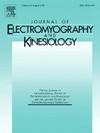表面肌电归一化方法对步态肌肉协同作用的影响。
IF 2.3
4区 医学
Q3 NEUROSCIENCES
引用次数: 0
摘要
本研究从正常发育的年轻人步行时收集的肌电图数据中,探讨了不同归一化方法对肌肉协同提取的影响。评估了六种方法:原始、试验内最大值、试验间最大值、任务特定最大值、幅度百分位数和单位方差。18名8-15岁的健康儿童参加了步行试验,同时记录和处理他们的肌电图信号。使用非负矩阵分解提取协同效应,并评估归一化方法对协同复杂性、结构和激活系数的影响。规范化选择显著影响协同数量、结构和时间特征。TSM和ITM方法产生更一致的协同效应,而MP和WTM则表现出更大的变异性。这项研究强调了选择合适的归一化方法进行强健肌肉协同分析的重要性,增强了对运动控制策略的理解,并有助于统一的处理工作流程。本文章由计算机程序翻译,如有差异,请以英文原文为准。
Effect of surface electromyography normalisation methods over gait muscle synergies
This study investigates the effect of different normalisation methods on muscle synergy extraction from EMG data collected while walking in typically developing young people. Six methods were evaluated: Raw, Within-Trial Maximum, Inter-Trial Maximum, Task-Specific Maximum, Magnitude Percentile, and Unit Variance. Eighteen healthy children aged 8–15 participated, performing walking trials while their EMG signals were recorded and processed. Synergies were extracted using non-negative matrix factorisation, and the influence of normalisation methods on synergy complexity, structure, and activation coefficients was assessed. Normalisation choice significantly influenced synergy number, structure, and temporal characteristics. TSM and ITM methods yielded more consistent synergies, while MP and WTM exhibited greater variability. This study highlights the importance of selecting appropriate normalisation methods for robust muscle synergy analyses, enhancing understanding of motor control strategies, and contributing to a unified processing workflow.
求助全文
通过发布文献求助,成功后即可免费获取论文全文。
去求助
来源期刊
CiteScore
4.70
自引率
8.00%
发文量
70
审稿时长
74 days
期刊介绍:
Journal of Electromyography & Kinesiology is the primary source for outstanding original articles on the study of human movement from muscle contraction via its motor units and sensory system to integrated motion through mechanical and electrical detection techniques.
As the official publication of the International Society of Electrophysiology and Kinesiology, the journal is dedicated to publishing the best work in all areas of electromyography and kinesiology, including: control of movement, muscle fatigue, muscle and nerve properties, joint biomechanics and electrical stimulation. Applications in rehabilitation, sports & exercise, motion analysis, ergonomics, alternative & complimentary medicine, measures of human performance and technical articles on electromyographic signal processing are welcome.

 求助内容:
求助内容: 应助结果提醒方式:
应助结果提醒方式:


